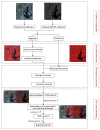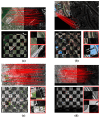OS-PSO: A Modified Ratio of Exponentially Weighted Averages-Based Optical and SAR Image Registration
- PMID: 39338704
- PMCID: PMC11435965
- DOI: 10.3390/s24185959
OS-PSO: A Modified Ratio of Exponentially Weighted Averages-Based Optical and SAR Image Registration
Abstract
Optical and synthetic aperture radar (SAR) images exhibit non-negligible intensity differences due to their unique imaging mechanisms, which makes it difficult for classical SIFT-based algorithms to obtain sufficiently correct correspondences when processing the registration of these two types of images. To tackle this problem, an accurate optical and SAR image registration algorithm based on the SIFT algorithm (OS-PSO) is proposed. First, a modified ratio of exponentially weighted averages (MROEWA) operator is introduced to resolve the sudden dark patches in SAR images, thus generating more consistent gradients between optical and SAR images. Next, we innovatively construct the Harris scale space to replace the traditional difference in the Gaussian (DoG) scale space, identify repeatable key-points by searching for local maxima, and perform localization refinement on the identified key-points to improve their accuracy. Immediately after that, the gradient location orientation histogram (GLOH) method is adopted to construct the feature descriptors. Finally, we propose an enhanced matching method. The transformed relation is obtained in the initial matching stage using the nearest neighbor distance ratio (NNDR) and fast sample consensus (FSC) methods. And the re-matching takes into account the location, scale, and main direction of key-points to increase the number of correctly corresponding points. The proposed OS-PSO algorithm has been implemented on the Gaofen and Sentinel series with excellent results. The superior performance of the designed registration system can also be applied in complex scenarios, including urban, suburban, river, farmland, and lake areas, with more efficiency and accuracy than the state-of-the-art methods based on the WHU-OPT-SAR dataset and the BISTU-OPT-SAR dataset.
Keywords: MROEWA; SIFT algorithm; enhanced matching method; image registration.
Conflict of interest statement
The authors declare no conflicts of interest.
Figures









References
-
- Wu Y., Hei G., Teng D., Wan Q., Zhao Y., Chen M., Xia Y., Jiang M., Li S. Optical image and SAR image registration based on position constraint; Proceedings of the Fourth International Conference on Geology, Mapping, and Remote Sensing (ICGMRS 2023); Wuhan, China. 14–16 April 2023; Bellingham, WA, USA: SPIE; 2024. pp. 347–352.
-
- Guillet J.P., Recur B., Frederique L., Bousquet B., Canioni L., Manek-Hönninger I., Desbarats P., Mounaix P. Review of terahertz tomography techniques. J. Infrared Millim. Terahertz Waves. 2014;35:382–411. doi: 10.1007/s10762-014-0057-0. - DOI
-
- Baraha S., Sahoo A.K. Synthetic aperture radar image and its despeckling using variational methods: A review of recent trends. Signal Process. 2023;212:109156. doi: 10.1016/j.sigpro.2023.109156. - DOI
-
- Ye Y., Zhang J., Zhou L., Li J., Ren X., Fan J. Optical and SAR image fusion based on complementary feature decomposition and visual saliency features. IEEE Trans. Geosci. Remote Sens. 2024;62:5205315. doi: 10.1109/TGRS.2024.3366519. - DOI
-
- Karim S., Tong G., Li J., Qadir A., Farooq U., Yu Y. Current advances and future perspectives of image fusion: A comprehensive review. Inf. Fusion. 2023;90:185–217. doi: 10.1016/j.inffus.2022.09.019. - DOI
Grants and funding
LinkOut - more resources
Full Text Sources
Miscellaneous

